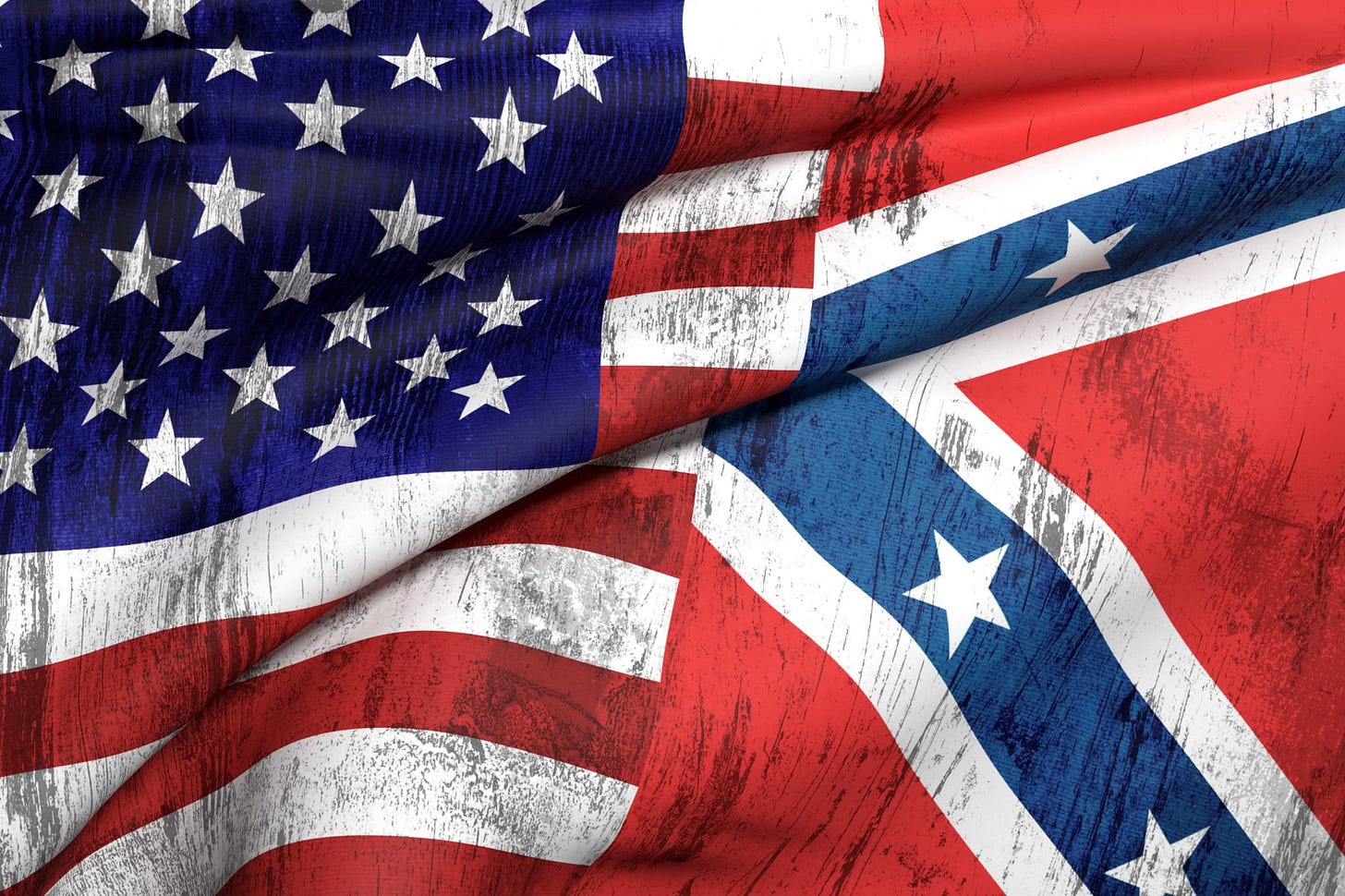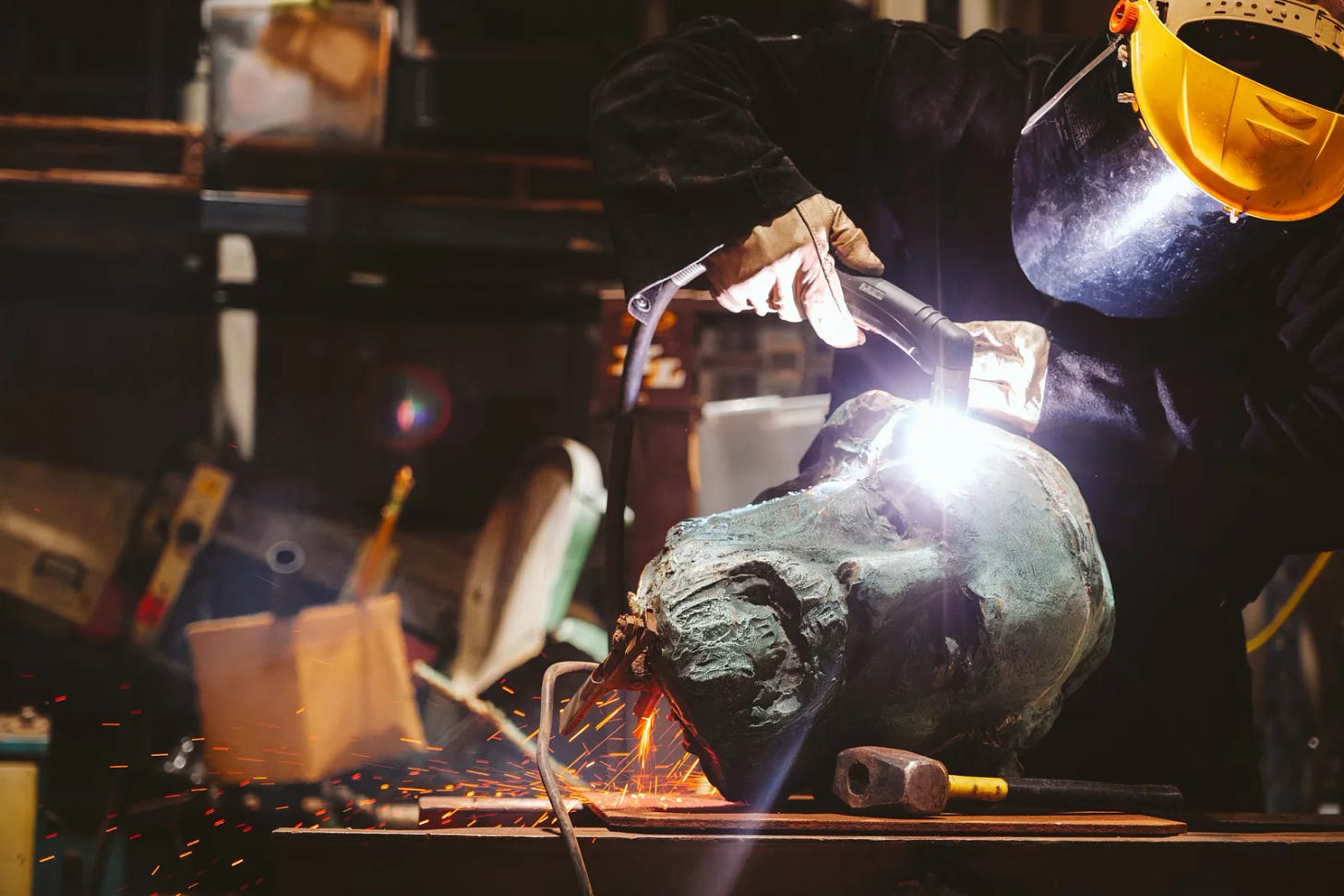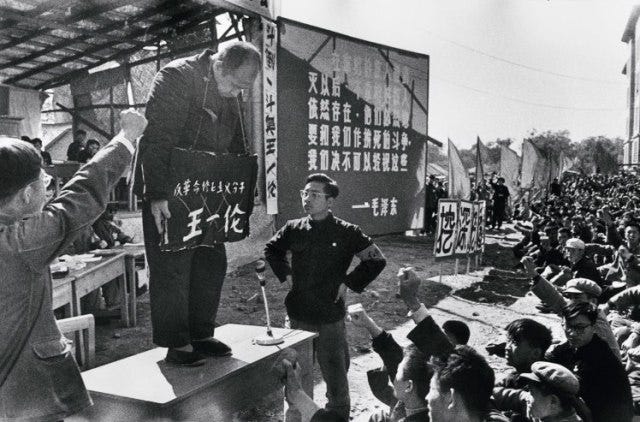The Ash Heap of History
General Robert E. Lee is the latest victim of America's worsening Cultural Revolution
“So this week it’s Robert E. Lee. I wonder, is it George Washington next week? Thomas Jefferson the week after? You really have to ask yourself, where does it stop?” - President Donald J. Trump
For over 100 years, Virginia’s Charlottesville showcased a prominent bronze statue of General Robert E. Lee, arguably one of the greatest leaders (military or otherwise) ever produced by our country. This statue had been standing for over 100 years when the Charlottesville City Council in 2017 voted 3-2 in favor of its removal, along with monuments depicting the famous General Stonewall Jackson and other “problematic” names. After years of delays due to multiple lawsuits, the statues were inevitably taken down in October 2023. Lee's statue was then unceremoniously delivered to a Charlottesville history museum, where a seemingly vindictive decision was made to obliterate Lee’s bronze likeness, by melting it down in a 2,250-degree furnace at a local foundry. Per the museum, the materials will be now repurposed into a new “inclusive” piece of public art once “ideas are collected” from city residents1.
As to what spurred this inevitable decision, Charlottesville’s Lee Park, where this statue previous stood, was made famous in 2017 by the “Unite the Right” rally, during which thousands turned out to protest the February 2017 decision by the Charlottesville City Council to remove this statue. Most of the protesters at that rally had no larger agenda than attempting to preserve a highly respected symbol of the region’s heritage. The rally began peacefully enough but physical altercations ensued shortly after hundreds of Antifa agitators showed up, dressed in all black and carrying various weapons. The ensuing chaos resulted in the loss of life for one protester.
Given the media’s one-sided portrayal of the incident, Lee’s statue never stood a chance. For the remainder of Trump’s presidency, his detractors continued to parrot the falsehood that Trump referred to neo-Nazis as “very fine people” that day. An honest reading of the actual transcript of President Trump’s comments, which remains available on the webpages of many media outlets2, reveals Trump said no such thing. Yet this lie was repeated so many times by Joe Biden, Barack Obama and others that over half of the country still believes it to be true to this day.
This mental disease has also infected West Point, where unelected government bureaucrats recently made the decision to remove the names of all officers who fought for the Confederacy - from every building, monument and marker on campus3. Never mind that after Lee surrendered to U.S. Grant at Appomattox in 1865, he spent the remainder of his life assisting the U.S. Government with reunification and willingly shared his bold and brilliant military tactics with U.S. military officers, to be admired, studied and analyzed by future generations of military leaders. Lee was also the superintendent of the same academy now removing his name from existence. The removals included three gigantic, beautiful bronze panels, each over 10 feet tall, with depictions of American legends such as Ben Franklin and Clara Barton.
The sad fate of General Lee is the latest in an alarming trend of similar incidents all across the nation, where local jurisdictions are removing historical symbols at an impressive rate. Wikipedia has a list of statues and memorials removed in the United States and across the globe since the George Floyd riots in 2020, either due to the decisions of cowardly local officials or irreparable destruction at the hands of looters and vandals during the “social justice” riots. The incredible length of this spreadsheet is truly frightening.4 Here is a very brief sampling of some of the casualties:
Kit Carson, Juniperro Serra, Theodore Roosevelt, Abraham Lincoln, Christopher Columbus, Thomas Jefferson, George Washington, Francis Scott Key, Ulysses S. Grant, J.E.B. Stuart, A.P. Hill, Frederick Douglass, Andrew Jackson, Hiawatha, Mahatma Ghandi, Meriwether Lewis, William Clark, and the Virgin Mary
Some may ask, “what’s the big deal, they’re just statues?” This surface-level question exhibits a remarkably poor understanding of global history, specifically the events that have preceded almost all tyrannical dictatorships of the past 200 years. There are many examples but a few stand out:
Mao’s cultural revolution in China involved destroying and/or removing from public view countless symbols of historical figures, sacred temples and works of art, all now gone forever5. Children were taught from a young age to disavow and reject anything before the present time, part of the “great leap forward.” This movement was highly successful in the short term, turning these children into informers against their own parents, who were often paraded through the streets and spat on (or far worse). As China’s history was gradually erased by its current leaders, all citizens were given Mao’s “little red book,” a shallow and silly collection of “philosophy” written by a highly pedestrian individual with no significant accomplishments of his own. All citizens were required to have it on their person at all times. Failure to display sufficient reverence and knowledge of this ridiculous book’s constipated missives landed people in gulags or put them directly in front of firing squads.
As Czarist Russia eventually fell to the Bolshevik revolution in 1918 and its resulting madness, the new group of leaders began a decades-long purge of all symbols of past Russian history. Ironically, many of society’s elites initially showed support for the “proletariat” by wearing red ribbons. Once the Bolsheviks took over, many of these “useful idiots” were eventually sent to the gulags as well. A decades-long purge of Russian history almost immediately followed. After Stalin assumed absolute power, these purges included mass executions and incarceration in the gulags made famous by Solzhenitsyn. So much of Russia’s history was erased and re-written over those long decades that even today, a majority of Russians amazingly view Stalin favorably, despite killing over 40 million of his own people. The CODA project (www.codastory.com) has put together a remarkable video history through interviews of actual survivors of the Soviet gulags. Even through the two-dimensional medium of an internet screen, the deep, haunting stares of the victims leave little to be said6.
Another sad example is the Taliban’s brutal takeover of modern day Afghanistan7, where some of the world’s oldest civilizations once resided. The country literally had thousands of temples, giant Buddhas, museums and priceless artifacts paying homage and respect to civilizations that flourished thousands of years ago. These were almost all systematically destroyed by Taliban “warriors”, under the pretense of a Koran passage where Mohammed allegedly implores those faithful to Allah to “destroy all idols.” The photos of the destruction caused by these ignorant savages in such a short period of time are hard to digest.
In addition to the maliciousness of destroying someone else’s hard work simply because it may “offend” someone, consider the damage done to a culture that can no longer have thought-provoking conversations about all of their history - the good, the bad and the ugly. Take the example of a father walking with his young son through the aforementioned Charlottesville park. The father might see the statue and decide to spend few minutes talking with his son about this incredibly horrible period in our country’s history, where men maimed and killed each other by the thousands in countless stalemate, seemingly pointless battles. Maybe this would spur the son to ask questions about the complicated genesis of this horrible conflict, one that pitted brother against brother and involved unspeakable carnage. The father would also have a chance to educate his son on the horrors of slavery and maybe explain the unfortunate economic realities that allowed it to continue for so long.
The son might learn that it’s better to judge men within the context of the era in which they lived, as opposed to only viewing their actions through the lens of what we now know in the modern day. They might realize General Robert E. Lee was faced with a Hobson’s choice of staying with the Federal government and being forced to take up arms against his fellow Virginians, or resigning his commission and casting his lot with the ultimately doomed Confederacy. Either way, historians generally agree General Lee’s impossible decision had effectively nothing to do with his personal views on slavery. Lee’s own memoirs contain very little on that topic.
In Shelby Foote’s fantastic three-volume collection on the Civil War8, he quotes a diary entry made by a Southern private who was dug in on the frontlines of one of the countless bloody conflicts. During a brief cease-fire, one of the Union soldiers on the other side of the line shouted a question, “Hey Johnny Reb, why do you keep fighting us?” The private replied “because y’all are down here.” I believe this simple exchange better explains why so many of the United States’ finest officers resigned their commissions and joined the Confederacy, reluctantly signing up to fight against Union officers with whom they fought side-by-side in previous wars. The vast majority owned no slaves and their memoirs contain almost no opinions on the institution. Complicated realities like this become lost forever if we surrender to our emotions and blindly tear down a statue because we believe the person it represents is “racist” or “problematic.”
It’s a well-worn cliche that those who ignore the past are doomed to repeat it. Whether it’s Robert E. Lee, Ulysses S. Grant, Stonewall Jackson, Tecumseh Sherman, George Washington or John Adams - the lessons we can learn from these historical figures (good and bad) are invaluable. Callously removing their names, likenesses and memories from public awareness serves no purpose other than reinforcing a tribal mentality, where broad labels such as “racist” are given to individuals from another era, despite never having met them or walked in their shoes during that time.
One can be reasonably confident those individuals conspiring to remove these statues in the name of “inclusivity” are not remotely interested in engaging in a critical analysis of our history. It is far easier to label Robert E. Lee, Stonewall Jackson, A.P. Hill, J.E.B. Stuart and anyone else who fought for the “bad” Confederacy as “racist bigots” and remove them from memory for the sake of short-term convenience. Perhaps we are only one generation away from Chinese-style “struggle sessions,” parading people through the streets and shaming them for various wrong think, as was documented during the peak of China’s cultural revolution.
Those who say it can never happen here are not paying attention to individuals like Xi Van Fleet9, who escaped communist China at a young age and has been warning us that we are exhibiting the same pre-revolutionary behaviors she witnessed in China so many years ago. Yeonmi Park’s auto-biography of her escape from North Korea is also a shocking read10. Park gives the same warnings as Fleet, adding that we are quickly approaching the point of no return. The Federal government’s ongoing assault on the constitutional rights of the January 6th prisoners makes a very strong argument we may already be there.






